
HOME
INTRO
SYMBOLS
ALMANAC
ECONOMY
GEOGRAPHY
STATE MAPS
PEOPLE
FORUM
NEWS
COOL SCHOOLS
STATE QUIZ
STATE LINKS
BOOK STORE
MARKETPLACE
NETSTATE.STORE
NETSTATE.MALL
GUESTBOOK
CONTACT US


Vermont State Mineral
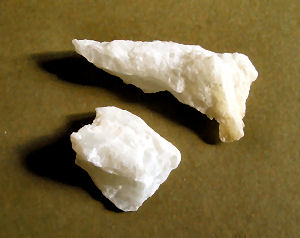
Vermont State Mineral: Talc
House Bill No. 678, cosponsored by Representatives Michael Obuchowski and Sean Campbell, called for the adoption of an official state gem (grossular garnet), and official state mineral (talc), and an official state rock (marble).
The proposal was made by Sue Hadden and sanctioned by Vermont mineralogical societies, clubs, geologists (including the recently retired State Geologist Charles Ratté), geology teachers, and industrialists within the mining industry.
"Just as the state has honored the hermit thrush, red clover, and sugar maple, it should honor its unique geologic heritage by naming a state gem, rock, and mineral and join the 95% of the other 50 states to have done so."
(Hadden 29)
Talc was considered a good choice for the official state mineral because;
- At the time, 20% of the combined United States—Canadian output was produced in Vermont, ranking the state second only to Montana.
- Soapstone, so important historically to Vermont's growth (and comfort!) is composed primarily of talc.
The United State Geological Survey (USGS) tells us that "U.S. talc is used in the production of ceramics (the main domestic use), paint, paper (for improving several paper qualities and in recycling processes), plastics (as a functional filler, providing rigidity to the plastic), roofing, rubber, cosmetics, flooring, caulking, and agricultural applications. As examples, talc is used in the ceramic substrate of catalytic convertors, and is found in wire and cable insulation, auto body putty, asphalt shingles, caulks, sealants, joint compounds, foam packaging, animal feed, pharmaceuticals, chewing gum, candy, gaskets, hoses, belts, flooring (providing softness and flexibility), insecticide carriers, and of course, baby and body powders. Thus, talc is a part of everyday life."
Talc, the State Mineral, is metamorphic in origin, formed in thin slivers of ocean crust left here after the continents collided. Generally found in southwestern Vermont, it is green in color and very soft.
In 1990, Vermont ranked second only to California among the states which produce talc.
Ground talc is used in plastics, paper, rubber and paint.
------- from Office of the Secretary of State,
Vermont Legislative Directory and State Manual,
Biennial Session, 1993-1994, p. 25.
Though two largest producers are mentioned above, Montana and California, they were declared in different years. Regardless of the number one producer, the consensus was that Vermont was the second biggest producer of talc at the time.
Evidently, as the legislative process proceeded, there were no objections to declaring talc the state mineral.
But some dust was kicked up about naming marble the state rock!
Vermont Law
The following information was excerpted from the Vermont Statutes Annotated, Title 1, Chapter 11, Section 508.
TITLE ONE. GENERAL PROVISIONS
CHAPTER 11. FLAG, INSIGNIA, SEAL, ETC.
1 V.S.A. § 508 (2012)
§ 508. State mineral
The state mineral shall be talc.
HISTORY: Added 1991, No. 221 (Adj. Sess.), § 3, eff. May 28, 1992.
Sources...
Hadden, Sue H. "Proposal to the Vermont State Legislature to Name a State Gem, Rock, and Mineral." Quarterly Newsletter of the Vermont Geological Society. 19.1 (1992): 29. Print.
The United State of America. United State Geological Survey (USGS). U.S. Talc—Baby Powder and Much More. USGS, 2002. Print.
"Vermont Statutes Annotated." LexisNexis, a division of Reed Elsevier Inc.. LexisNexis, a division of Reed Elsevier Inc., n.d. Web. 22 Feb 2012. .
"Vermont Emblems, Facts and Figures." Vermont Department of Libraries. State of Vermont, n.d. Web. 22 Feb 2012. .
Shearer, Benjamin F. and Barbara S. State Names, Seals, Flags and Symbols: A Historical Guide Third Edition, Revised and Expanded. Westport, Conn: Greenwood Press, 3 Sub edition, 2001.
Additional Information
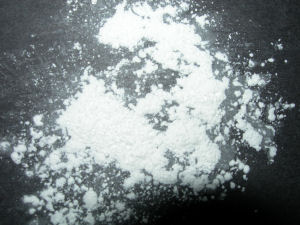
Vermont State Mineral: Talc in form of talcum powder
Licensed under the
Creative Commons Attribution-Share Alike 3.0 Unported license.
Welcome to Industrial Minerals of Vermont: 200 Years and Going Strong: by Diane Conrad and Diane Vanacek (early 1990s), with portions updated in 2005 by Sarah King.
U.S. Talc—Baby Powder and Much More :
U.S. Geological Survey fact sheet 0065-00 Version 1.0.
:
U.S. Geological Survey fact sheet 0065-00 Version 1.0.
Talc Investigations in Vermont :
U.S. Geological Survey circular "Talc investigations in Vermont, preliminary report"; 1951; CIR; 95; Chidester, A. H.; Billings, M. P.; Cady, W. M.
:
U.S. Geological Survey circular "Talc investigations in Vermont, preliminary report"; 1951; CIR; 95; Chidester, A. H.; Billings, M. P.; Cady, W. M.
State minerals: Complete list of official state minerals from NETSTATE.COM.
More symbols & emblems: Complete list of official Vermont state symbols from NETSTATE.COM.
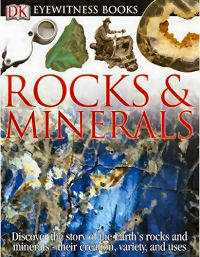
Eyewitness Books: Rocks & Minerals
Eyewitness Books: Rocks & Minerals, by Chris Pellant, R.F. Symes 72 pages. DK CHILDREN (August 2, 2004) Reading level: Ages 9-12. Here is a spectacular and informative guide to the amazing world beneath our feet. Stunning color photographs of rocks, fossils, minerals, precious metals, crystals, jewels and gemstones give the reader a unique "eyewitness" insight into the evolution and composition of the Earth. See rocks that have come from outer space, stalactites as old as dinosaurs, the strange and beautiful shapes of natural crystals and priceless nuggets of gold, silver and platinum. Learn what the Earth is made of - and how its rocks were formed, how early humans made the first flint tools and how diamonds and precious stones are cut, polished, and made into jewelry. Discover how prehistoric animals are preserved today as fossils, how volcanoes work, how rocks are formed from molten lava, how minerals and metals are mined and how pebbles on the seashore are worn down into sand, and much, much more!
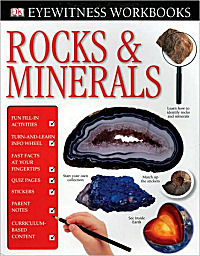
Eywitness Workbook: Rocks & Minerals
Eyewitness Workbooks: Rocks & Minerals, 48 pages. DK CHILDREN; Workbook edition (June 16, 2008) Reading level: Ages 9-12. Perfect for getting ahead at school or just stimulating children's interest, this groundbreaking series of workbooks leaves the competition in the dust, with exciting subjects, 48 full-color pages, a turn-and-learn info wheel, and special carrying folders. Never before have there been workbooks with so many opportunities for fun and interactive learning!
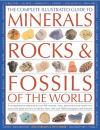
The Complete Illustrated Guide to Minerals, Rocks & Fossils of the World, by John Farndon and Steve Parker. 512 pages. Publisher: Lorenz Books, an imprint of Anness Publishing (June 16, 2010) A comprehensive reference to over 700 minerals, rocks, plants and animal fossils from around the globe and how to identify them, with over 2000 photographs and artworks.
This stunning and expert book provides a complete reference for anyone interested in the earth sciences. Each section of the book starts with an informative introduction explaining how the phenomena have formed and their major defining characteristics, the habitats in which they are typically found and where the best examples are located around the world.
How-to techniques for the amateur geologist and palaeontologist show how to extract samples safely, and how to identify, date and classify them. There are step-by-step instructions on simple home testing methods to gauge rock and mineral colour, hardness, cleavage, lustre, tenacity and transparency. There is practical guidance on the best ways to clean, preserve and then display the specimens to build a superb collection of your own.
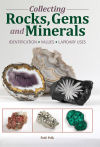
Collecting Rocks,
Gems & Minerals
Patti Polk
Collecting Rocks, Gems & Minerals, by Patti Polk. 272 pages. Publisher: Krause Publications (May 13, 2010) Collecting Rocks, Gems and Minerals takes you from having a casual interest in rocks to being a true collector, and it serves as the only book of its kind to have values for these beautiful offerings from nature.
The easy-to-use, and durable design of this book makes it the perfect guide to use out in the field, and it:
- Covers both lapidary and mineral display materials
- Includes organics such as amber, bone, coral, pearl and shell
- Lists chemical group, system, hardness, opacity, fracture, specific gravity and more
- Provides values and tips for locating, buying and collecting
- Contains 650+ full-color photos
Peterson First Guides: Rocks and Minerals, by Frederick H. Pough. 128 pages. Houghton Mifflin Harcourt (August 15, 1998) Written and designed for the beginner, this book describes and illustrates the most common and interesting rocks and minerals, from simple sandstone to exotic gems. Illustrated with dozens of beautiful color photographs, it tells how these rocks and minerals formed and how to identify them--and includes tips on collecting.
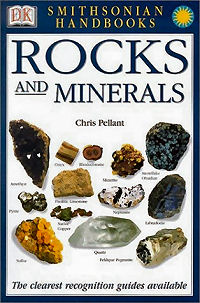
Rocks and Minerals
by Chris Pellant
Rocks & Minerals, by Dougal Dixon. 160 pages. Fireside (August 15, 1992) Beginning with a history of the earth's formation and development, this book explores the substances that compose the planet, movements within the earth, the surface effects of weather and water, and underground landscapes. It shows you how to search for, identify, and extract samples of various rocks and minerals, and for each rock and mineral type there is a brief mineralogy and explanation of its locations. There are also sections on mapping, preparing, and curating specimens, and geological sites on the six continents. Packed with more than 200 full-color illustrations, this comprehensive guide is the essential practical companion for natural science enthusiasts everywhere.
Smithsonian Handbooks: Rocks and Minerals, by Chris Pellant. 256 pages. DK ADULT; 1st edition (September 1, 2002) The Smithsonian Handbook of Rocks and Minerals combines 600 vivid full--color photos with descriptions of more than 500 specimens. This authoritative and systematic photographic approach, with words never separated from pictures, marks a new generation of identification guides. Each entry combines a precise description with annotated photographs to highlight the chief characteristics of the rock or mineral and distinguishing features.
Field Guide to North American Rocks and Minerals, National Audubon Society. 856 pages. Knopf; 1st Edition (5th Printing) edition (May 12, 1979) Perfect for mountain climbers and hikers, this valuable reference covers more rocks and minerals in North America than any other available guide. 794 full-color photographs depict all the important rocks, gems, and minerals -- in many variations of color and crystal form -- and the natural environments in which they occur; written descriptions provide information on field marks, similar rocks and minerals, environment, areas of occurrence, and derivation of names. Includes a guide to mineral collecting and a list of rock-forming minerals

